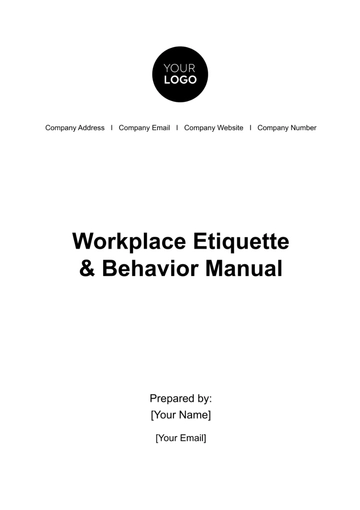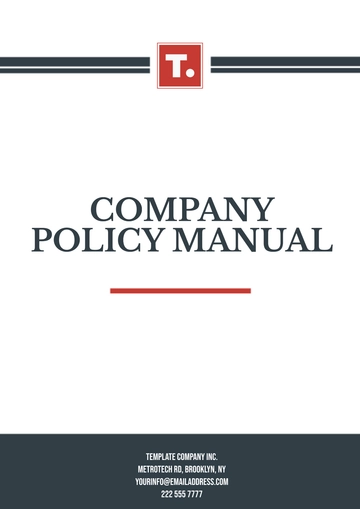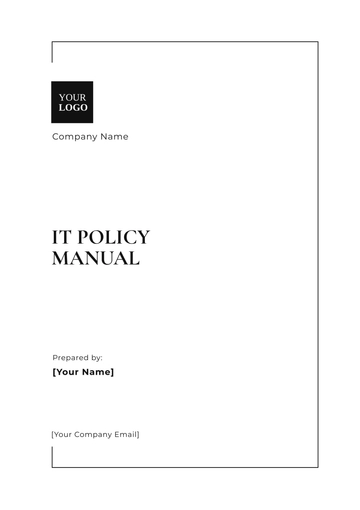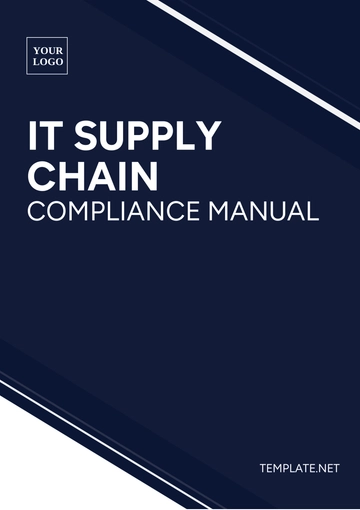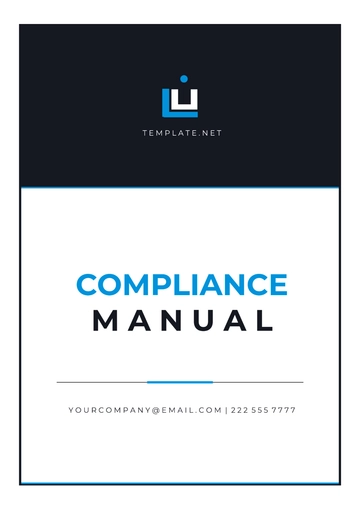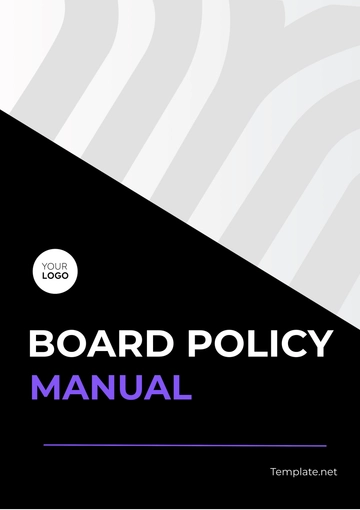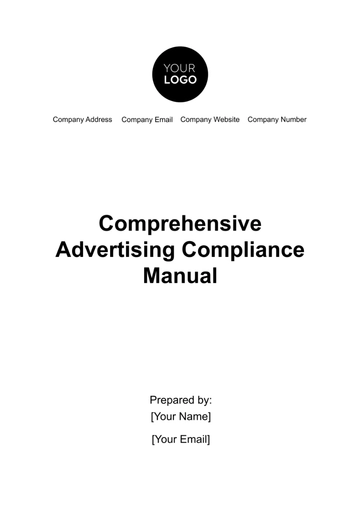Free Advertising Standards Policy Manual

I. Introduction and Purpose
This manual serves as a comprehensive guide for the creation, review, and dissemination of advertising content within our organization. It ensures that all advertising materials are in strict compliance with legal and ethical standards and align with our company's values and image. Adherence to these standards mitigates legal risks, upholds our brand reputation, and fosters trust with our consumers and partners.
II. Legal Compliance
To ensure our advertising practices align with legal standards, we adhere to a variety of laws and regulations. The table below provides a detailed overview:
Region | Relevant Laws | Key Compliance Points |
USA | FTC Act, COPPA, Lanham Act | Truth in advertising, child protection, trademark law |
EU | GDPR, UCPD, AVMSD | Data privacy, unfair practices, audiovisual media |
China | Advertising Law of PRC, Cybersecurity Law | False advertising prohibition, online data security |
India | ASCI Code, IT Act | Decency, honesty, fairness, information technology |
Application in Various Media
Television and Radio: Compliance with the Children’s Television Act and FCC regulations on advertising hours, product placements, and disclosures in sponsored content.
Digital and Online: Observance of GDPR for EU audiences, with specific attention to cookie policies, consent for data collection, and targeting mechanisms.
Print Media: Adherence to the truth-in-advertising standards set by the FTC, ensuring all claims are substantiated, and disclaimers are clear and conspicuous.
Compliance Procedures
Legal Review: All advertising campaigns must undergo a legal review process to ensure compliance with the relevant jurisdictional laws.
Continuous Training: Regular training sessions for the marketing team on legal updates and best practices.
III. Ethical Standards
Our commitment to ethical advertising is grounded in principles of honesty, responsibility, and respect for consumer rights.
Honesty and Accuracy
Substantiation of Claims: All claims about products or services must be supported by credible evidence.
Accuracy in Representation: Visuals and demonstrations in ads must accurately represent the product’s capabilities.
Responsibility
Avoiding Exploitation: Advertising must not exploit vulnerable groups or individuals’ insecurities.
Environmental Claims: Ads with environmental claims must be backed by reliable scientific evidence.
Respect for Consumer Rights
Privacy and Data Protection: Ensuring consumer data obtained through advertising channels is protected and used ethically.
Consent and Opt-out Options: Providing clear options for consumers to opt-out of targeted advertising.
IV. Target Audience and Content Suitability
Understanding and respecting the diversity of our audience is crucial in crafting suitable content.
Guidelines by Audience Type
Children and Teens: Ads targeting this demographic should promote positive values and avoid material that could be harmful or misleading.
General Audience: Content should be suitable for a broad audience, avoiding extreme views, offensive language, or imagery.
Content Suitability Standards
Cultural Relevance: Ads must be culturally relevant and sensitive, avoiding content that could be perceived as disrespectful or inappropriate in certain cultures.
Age-Appropriate Material: Ensuring content is suitable for the age group it targets, particularly in cases of products meant for adults, such as alcoholic beverages.
Monitoring and Feedback
Consumer Feedback: Actively seeking and considering consumer feedback on our advertising content to ensure it remains appropriate and respectful.
Regular Assessments: Conducting regular assessments of advertising content to ensure ongoing suitability and compliance with these guidelines.
V. Cultural Sensitivity and Diversity
Cultural sensitivity in advertising is not just a moral imperative but also a business necessity. Our commitment to cultural sensitivity and diversity ensures that our advertisements resonate positively across different cultures and communities.
Diversity and Inclusion Guidelines
Inclusive Representation: Ads should depict a diverse range of individuals, reflecting various ethnicities, ages, genders, abilities, and orientations.
Cultural Relevance: Ads should be tailored to be culturally relevant and sensitive to the local customs and traditions of the target market.
Avoiding Cultural Missteps
Research and Consultation: In-depth research and consultation with cultural experts to ensure ads are appropriate and respectful.
Feedback Mechanisms: Establishing channels for receiving and addressing feedback from diverse audiences to continuously improve cultural sensitivity.
Cultural Sensitivity Table
Aspect | Consideration | Example |
Language | Use of appropriate language and dialects. | Translating ads accurately, avoiding slang. |
Visuals | Respectful and accurate cultural representation. | Avoiding cultural stereotypes in imagery. |
Context | Understanding cultural context and sensitivities. | Being aware of local customs, holidays, and norms. |
Product Relevance | Suitability of the product for the culture. | Adapting products to meet local needs and tastes. |
VI. Digital Advertising Standards
The digital landscape is continually evolving, and our advertising strategies must evolve with it. Digital advertising standards focus on respecting user privacy, ensuring data security, and adapting to the rapidly changing online environment.
Online and Social Media Advertising Guidelines
Data Privacy Compliance: Strict adherence to data privacy laws such as GDPR and CCPA, ensuring user data is handled responsibly.
Content Authenticity: Ensuring all digital ads are truthful, avoiding deep fakes or misleading content.
Email Marketing and Anti-Spam Compliance
Opt-In Policies: Requiring explicit consent from users before sending marketing emails.
Clear Unsubscribe Options: Providing easily accessible options for users to unsubscribe from email communications.
Digital Advertising Compliance Table
Area | Standard | Example |
User Data | Consent-based data collection and usage. | Obtaining explicit consent for data collection. |
Ad Placement | Ethical and legal ad placement. | Avoiding placement on controversial or harmful sites. |
Content Targeting | Respectful and non-invasive targeting practices. | Avoiding overly aggressive retargeting strategies. |
Platform Rules | Compliance with individual platform policies. | Adhering to specific rules of social media platforms. |
Monitoring Digital Trends
Regular Updates: Keeping abreast of changes in digital advertising standards and technologies.
Training and Development: Continuously training our team in the latest digital advertising practices and ethical guidelines.
VII. Comparative Advertising
Comparative advertising is a strategy that involves directly or indirectly comparing a product or service with competitors. While effective for highlighting the advantages of our products, it requires careful handling to avoid legal issues and maintain ethical standards.
Principles of Comparative Advertising
The core principle of comparative advertising is fairness and accuracy. All comparisons should be based on factual, verifiable information and should not mislead the consumer.
Legal and Ethical Considerations
Truthfulness: Ensuring that all comparative claims can be substantiated.
Non-Deception: Avoiding any possibility of misleading the consumer about the nature of the comparison or the products involved.
Comparative Advertising Compliance Table
Aspect | Requirement | Example |
Claim Substantiation | Evidence supporting comparative claims. | Independent tests or studies verifying claims. |
Direct Comparisons | Clear and factual comparisons with competitors. | Comparing specific features or prices. |
Implicit Comparisons | Subtle comparisons that are still factual. | Highlighting unique features not found in competitors. |
Legal Review | Ensuring compliance with advertising laws. | Legal team approval of comparative content. |
VIII. Endorsements and Testimonials
Endorsements and testimonials can significantly influence consumer decisions. They must, therefore, be authentic, verifiable, and in line with regulatory standards.
Endorsements must reflect the honest opinions, findings, or experiences of the endorser. Any material connection between the endorser and our company must be disclosed. Testimonials used in advertising should be from individuals who have genuinely used the product or service and reflect their true experience.
Endorsements and Testimonials Compliance
Aspect | Requirement | Example |
Endorser Authenticity | Genuine experience or use of the product. | A real user's success story with the product. |
Claim Verification | Substantiation of any claims made. | Scientific evidence supporting health claims. |
Disclosure | Transparency about the relationship with endorsers. | Clear disclosure of paid partnerships. |
Legal Compliance | Adherence to relevant advertising laws. | Reviewing endorsements as per FTC guidelines. |
IX. Intellectual Property
Intellectual property (IP) plays a crucial role in advertising. Respecting IP rights not only avoids legal issues but also upholds the integrity and creativity of our advertising content. Understanding and adhering to IP laws is essential. This includes the proper use of copyrighted material, trademarks, and patents within our advertising content.
Intellectual Property Considerations
Copyrighted Material: Use of images, music, video, or text must either be original, licensed, or fall under fair use.
Trademark Usage: Careful use of trademarks to avoid infringement and confusion about brand association or endorsement.
Intellectual Property Compliance
Aspect | Requirement | Example |
Copyright Usage | Legal use of copyrighted material. | Licensing images or music for ad campaigns. |
Trademark Clearance | Ensuring no trademark infringement. | Verifying trademarks are not used improperly. |
Original Content | Creating or commissioning original works. | Developing unique ad content to avoid IP issues. |
Licensing Agreements | Maintaining records of all licensing agreements. | Documentation of permissions for IP use. |
IP Monitoring and Training
Regular Training: Providing regular training sessions for the team on IP laws and best practices in advertising.
Compliance Audits: Conducting periodic audits to ensure all advertising content complies with IP laws and company policy.
X. Monitoring and Enforcement
Effective monitoring and enforcement of our advertising standards are critical to maintaining compliance, upholding our brand's reputation, and ensuring ethical practices.
Review and Approval Process
Pre-Publication Review: All advertising materials must undergo a thorough review process to ensure compliance with legal and ethical standards.
Approval Protocols: Establishing clear protocols for the approval of advertising content, including checks for legal compliance, ethical standards, and alignment with company values.
Monitoring and Enforcement Compliance Table
Aspect | Procedure | Example |
Internal Audits | Regular audits of advertising content. | Bi-annual reviews of campaign compliance. |
Violation Reporting | System for reporting and addressing violations. | Hotline or portal for reporting non-compliant ads. |
Disciplinary Actions | Actions taken against non-compliance. | Retraction of ads, warnings, or training sessions. |
Compliance Training | Ongoing training for staff in advertising standards. | Workshops and e-learning modules on ad standards. |
Continuous Improvement and Feedback
Feedback Mechanisms: Implementing channels for feedback from employees, consumers, and stakeholders to improve advertising practices.
Regular Policy Updates: Updating the advertising standards policy regularly to reflect changes in laws, market trends, and societal expectations.
- 100% Customizable, free editor
- Access 1 Million+ Templates, photo’s & graphics
- Download or share as a template
- Click and replace photos, graphics, text, backgrounds
- Resize, crop, AI write & more
- Access advanced editor
Elevate your advertising standards with Template.net's Advertising Standards Policy Manual Template. This editable and customizable resource, powered by our Ai Editor Tool, enables you to define and enforce advertising guidelines. Ensure compliance, consistency, and ethical practices across all advertising endeavors with this comprehensive template.


